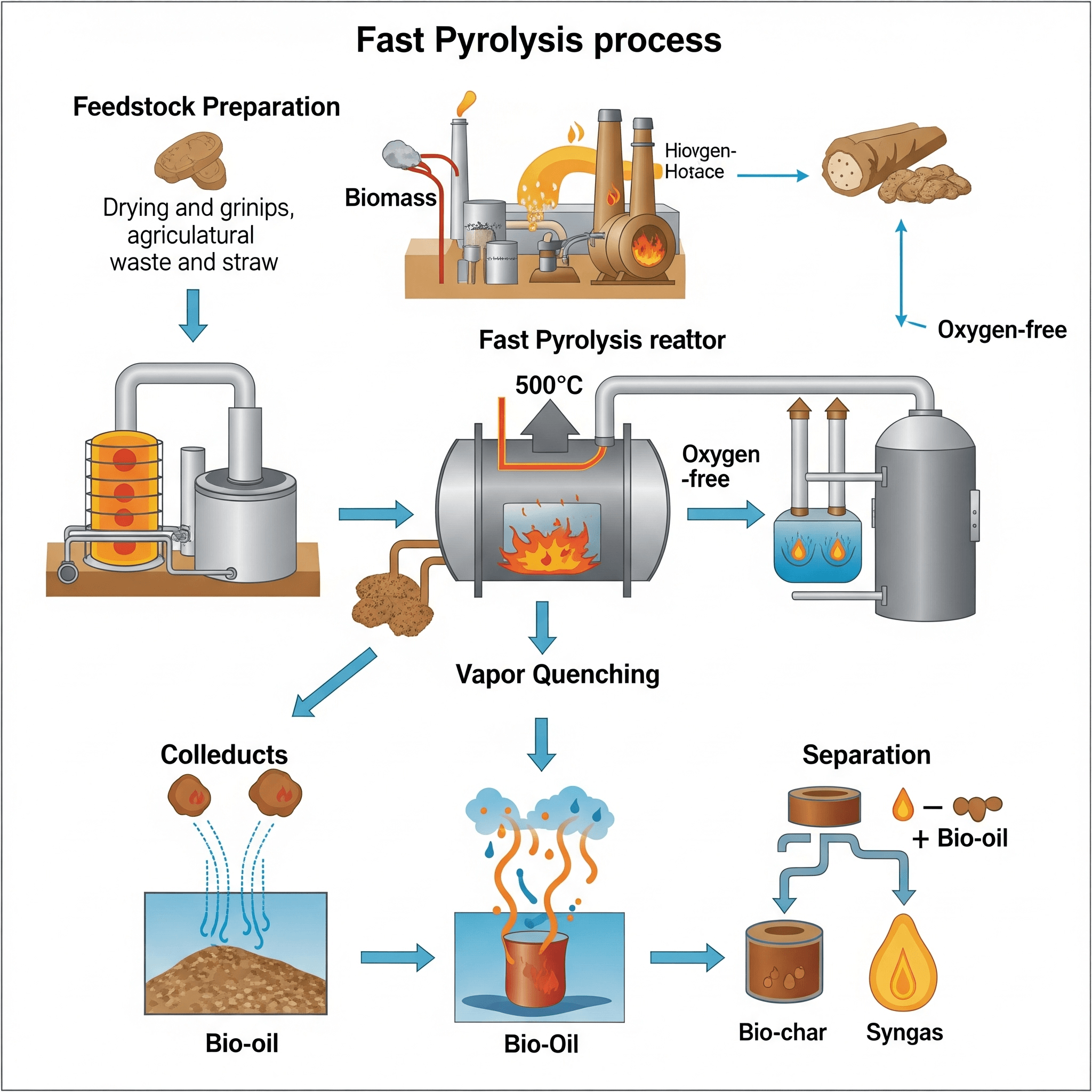What is Bio-oil?
Bio-oil is a liquid fuel derived from biomass through the process of pyrolysis (thermal decomposition in the absence of oxygen). It is a dark brown, viscous liquid containing hundreds of organic compounds and water.
Production Process: Fast Pyrolysis

What is Pyrolysis?
- Pyrolysis is the process of thermally degrading biomass at 300–600°C in the absence of oxygen.
- Fast pyrolysis is preferred for bio-oil production because it maximizes the yield of liquid products.
➤ Steps:
- Feedstock preparation: Biomass (wood chips, agricultural waste, straw) is dried and ground.
- Fast Pyrolysis Reactor: Heated rapidly to 500°C in an oxygen-free environment.
- Vapor Quenching: The hot vapors are quickly cooled to produce liquid bio-oil.
- Separation: The bio-oil is collected; bio-char and syngas are separated as co-products.
Properties of Bio-oil
|
Property |
Description |
|
Appearance |
Dark brown, viscous liquid |
|
Energy content |
16–19 MJ/kg (lower than petroleum) |
|
pH |
Acidic (pH 2–4) |
|
Water content |
15–30% |
|
Density |
1.1–1.3 g/cm³ |
|
Stability |
Thermally and chemically unstable |
|
Oxygen content |
High (~35–40%) |
Feedstocks for Bio-oil Productionleke
- Wood chips
- Agricultural residues (wheat straw, rice husk, sugarcane bagasse)
- Forestry residues
- Energy crops (switchgrass, miscanthus)
- Organic municipal solid waste
Advantages of Bio-oil
- Renewable and sustainable
- Utilizes agricultural/forestry waste
- Can be burned for heat or electricity
- Can be upgraded to transportation fuels
- Carbon-neutral (biomass reabsorbs CO₂ during growth)
- Contains less sulfur and nitrogen than fossil fuels
Limitations of Bio-oil
- Low heating value compared to fossil fuels
- High water and oxygen content reduce combustion efficiency
- Corrosive and unstable during storage
- Requires upgrading (hydrotreating) for use in engines
- Viscous and may need preheating
Upgrading of Bio-oil
To be used as a transportation fuel, bio-oil must undergo:
- Hydrotreating: Removes oxygen using hydrogen
- Catalytic cracking: Breaks down large molecules
- Emulsification: Mixed with diesel for fuel blends
Applications of Bio-oil
- Energy and Heating; Can be burned in boilers and furnaces for heat and power generation
- Industrial Use; As a feedstock for chemicals and resins, Carbon black production
- Transport Fuels (after upgrading) Can be upgraded into diesel or gasoline substitutes
- Chemical Industry; Source of phenols, acetic acid, furfural, etc.
Environmental Impact
- Reduces waste by using agricultural residues
- Carbon-neutral fuel
- Low NOx and SOx emissions
- May emit VOCs if not properly burned or stored
Bio-oil vs. Biodiesel vs. Petroleum
|
Feature |
Bio-oil |
Biodiesel |
Petroleum Diesel |
|
Source |
Biomass (via pyrolysis) |
Vegetable oil (via transesterification) |
Fossil fuel |
|
Energy content |
Low (16–19 MJ/kg) |
Medium (~37 MJ/kg) |
High (~45 MJ/kg) |
|
Stability |
Low |
High |
High |
|
Oxygen content |
High |
Low |
Very low |
|
Water content |
High |
Low |
Very low |
|
Use in Engines |
Needs upgrading |
Direct use (B20/B100) |
Direct use |
Future Prospects
- Research on stabilizing bio-oil for direct engine use
- Co-firing bio-oil with coal in power plants
- Decentralized pyrolysis units near biomass sources
- Development of integrated biorefineries
- Focus on bio-oil from algae and municipal waste

